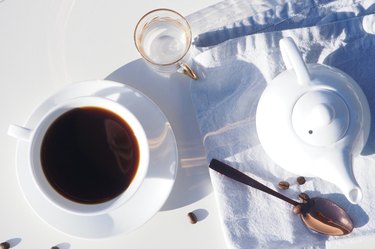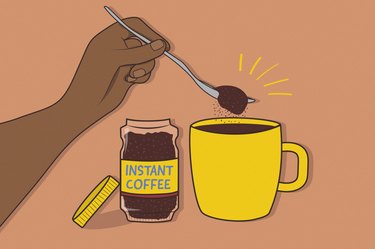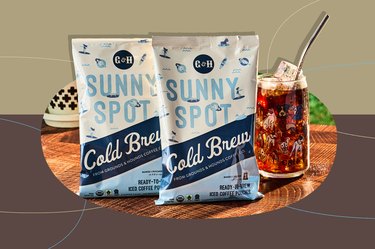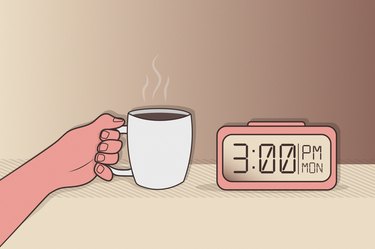
Picture this: You slept through your alarm, you're running late to work and when you desperately reach for your instant coffee fix, you realize that you've run out (argh). But wait, you have some ground coffee in the back of the cupboard. Still, there's no time to brew a pot. If only you could heat up one quick cup.
You wonder: Can I add hot water to ground beans and drink it like instant coffee?
Video of the Day
Video of the Day
"In a technical sense, the answer to this question is yes," says Jon Allen, co-founder of Onyx Coffee Lab. "When you add water to ground coffee, the extraction process begins instantly — and that extraction process is what results in your cup of coffee," Allen says.
In fact, this trouble-free technique is quite similar to other unfiltered brewing methods such as French press coffee, he says. But can you drink coffee grounds? And more importantly, is this unfiltered process even safe for your health?
Here, we debate the pros and cons (including those related to your health) of brewing ground coffee like instant varieties — plus tips for how to do it for the tastiest cup.
Instant Coffee vs. Ground Coffee
“Instant coffee is dehydrated brewed coffee,” Allen says. “When hot water is added to the dehydrated coffee crystals, they are instantly rehydrated, making for an extremely convenient and mess-free coffee-making experience,” he says.
“In contrast, ground coffee still needs to undergo the brewing process in order to extract out the flavors, aromas, mouthfeel and caffeine from the coffee beans,” Allen explains.
Pros of Using Ground Coffee Like Instant
"The main pro to drinking ground coffee like instant coffee is that it's an easy solution if you don't have a device to make coffee or any instant coffee on hand," says Maxine Yeung, RD, CPT, registered dietitian and founder of The Wellness Whisk.
Plus, this technique tends to create a different coffee texture that may be tantalizing to your tastebuds. "You might prefer the oilier feel of making coffee this way," Yeung says.
OK, but does this café-making process have any health perks? Perhaps. "Coffee beans contain two natural oils called cafestol and kahweol," Yeung says.
Also known as diterpenes, these oily substances, which usually get strained out when you use a filter, stick around your mug when you make coffee like this. Each cup of unfiltered brew boasts between 3 and 6 milligrams of diterpenes, according to a September 2019 review in the International Journal of Molecular Sciences.
And this might be a good thing because "some research shows that cafestol and kahweol may have anti-inflammatory effects and anti-cancer properties as they block the activation of carcinogens," Yeung says.
Is There a Certain Roast That Works Best?
“The best type of roast to use is the one you prefer flavor- and caffeine-wise,” Yeung says. “Darker roasts generally have a richer, smoky flavor, less caffeine and are less acidic,” she says.
Possible Drawbacks of Using Ground Coffee Like Instant
But making your coffee this way also comes with a few potential health risks as well.
Might Raise Cholesterol
Though cafestol and kahweol appear to demonstrate anti-inflammatory and cancer-protective properties, some studies show that drinking boiled and unfiltered coffee (which contains higher amounts of these oily substances) may raise LDL cholesterol and triglyceride levels over time, Yeung says.
You'll Get More Caffeine
What's more, sipping on ground coffee prepared like instant coffee will "technically increase the amount of caffeine being consumed," Allen says.
While this isn't inherently a bad thing, some people are more sensitive to caffeine, which can cause insomnia, nervousness, heart palpitations and the jitters, according to Harvard Health Publishing. So if you're susceptible to these caffeine-related side effects, this brewing method may not be for you.
Tip
Up to 400 milligrams of caffeine (about 4 cups of coffee) daily is safe for most adults.
How to Use Ground Coffee as Instant Coffee
Whether you're out of instant and in a pinch, or you simply don't want to use a brewer, follow these simple steps to create a quick, quality cup of coffee every time.
For one cup:
- Boil 1 cup of water.
- Let it cool for a minute.
- Pour it over one to two tablespoons of grounds (depending on how strong you like your coffee).
- Stir well and let it sit for a minute before drinking.
While this unfiltered process is fast, straightforward and convenient, it's not without a few downsides. "Unfortunately, there will always be some grounds floating around using this method because grounds do not dissolve like instant coffee," Yeung says.
Here are a few tips to limit loose grinds for a cleaner cup:
1. Strain the Coffee
"The only way to get rid of most of the floating grounds is to strain the coffee after you've mixed it with water," Yeung says. "You can use a paper or metal filter, a thin dish towel or a paper towel or napkin," she says.
2. Let the Grounds Settle
"Letting the grounds fully settle to the bottom of the cup before drinking may help," Yeung says. To speed this along, try adding a drizzle of cold water on top, which will sink the grinds, she says.
"However, you'll still have some residue with your sips, especially towards the end of your cup," she adds.
3. Pour Your Coffee Into Another Cup
"You can also try pouring the coffee into a new cup after it's finished brewing, leaving as many of the grounds as you can in the initial cup," Yeung says.
4. Regrind Larger Pieces Before Brewing
"To make sure your coffee grounds are fine enough, you can sift them to get out the larger pieces and regrind those," Yeung says.
This may help keep big floaters at bay once you've brewed your coffee.
Tip
“Since coffee that’s been ground spoils quicker than whole coffee beans, I recommend grinding what you need each day, otherwise the flavor might be compromised,” Yeung says.
An Alternative: Cold Brew Coffee Concentrate
While quick and convenient, some might also find that this method doesn't please their palate the same way instant joe does.
"The reality is, simply stirring a small amount of ground coffee into water as you would with instant coffee is not going to result in a highly desirable cup, and you likely won't find yourself looking at that as an experience worth repeating," Allen says.
But another brewing method offers the same seamless coffee-making experience and tastes just as good (if not better) than instant coffee. "For someone interested in a convenient way to make coffee that requires very little preparation and clean up (and doesn't even require hot water), there is another great solution: cold brew coffee concentrate," Allen says.
"Brewing a small amount of coffee concentrate overnight is a great way to enjoy a quality cup of coffee without any mess and without a complicated morning routine."
Here's how to transform your coffee grounds into cold brew coffee concentrate.
For a single serving:
- Pour about 5 ounces of water over 2 tablespoons of very coarsely ground coffee. "If you prefer to contain your coffee grinds for easy disposal, try a filter bag — both reusable and disposable, even loose-leaf tea bags, can be used," Allen says.
- Let it sit for 8 to 16 hours, either in the fridge or on the counter. "The longer you leave it, the stronger your coffee concentrate will be," Allen says.
- Remove the coffee grinds, either by removing your filter bag or by pouring the coffee grind mixture over a straining cloth.
- Dilute your cold brew coffee concentrate to taste with additional cold water and ice or mix with ice and milk.
Was this article helpful?
150 Characters Max
0/150
Thank you for sharing!
Thank you for your feedback!


